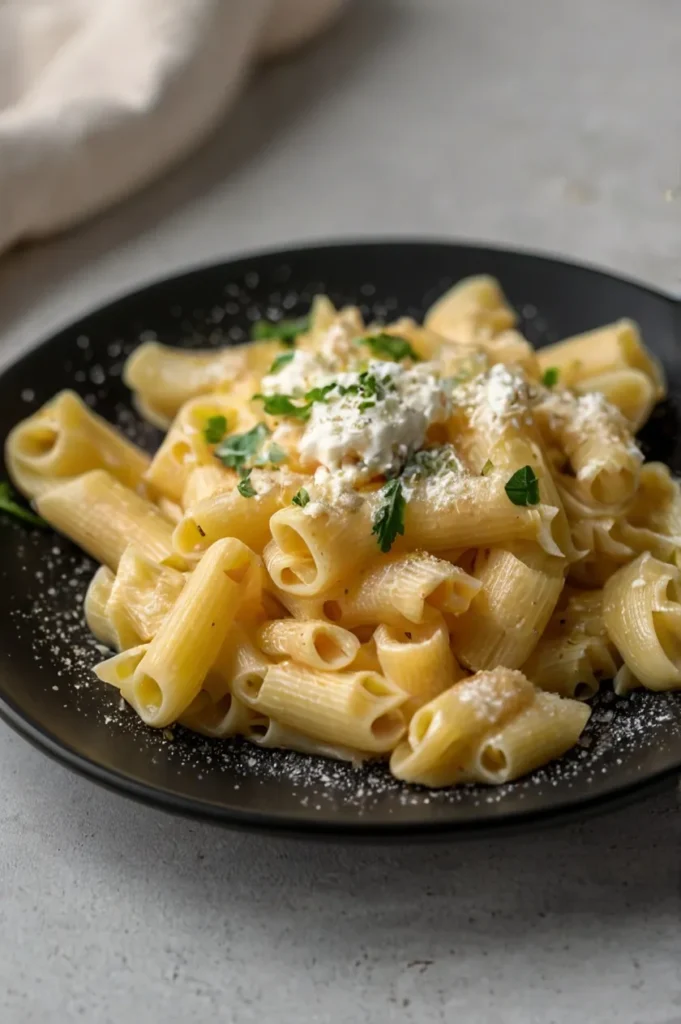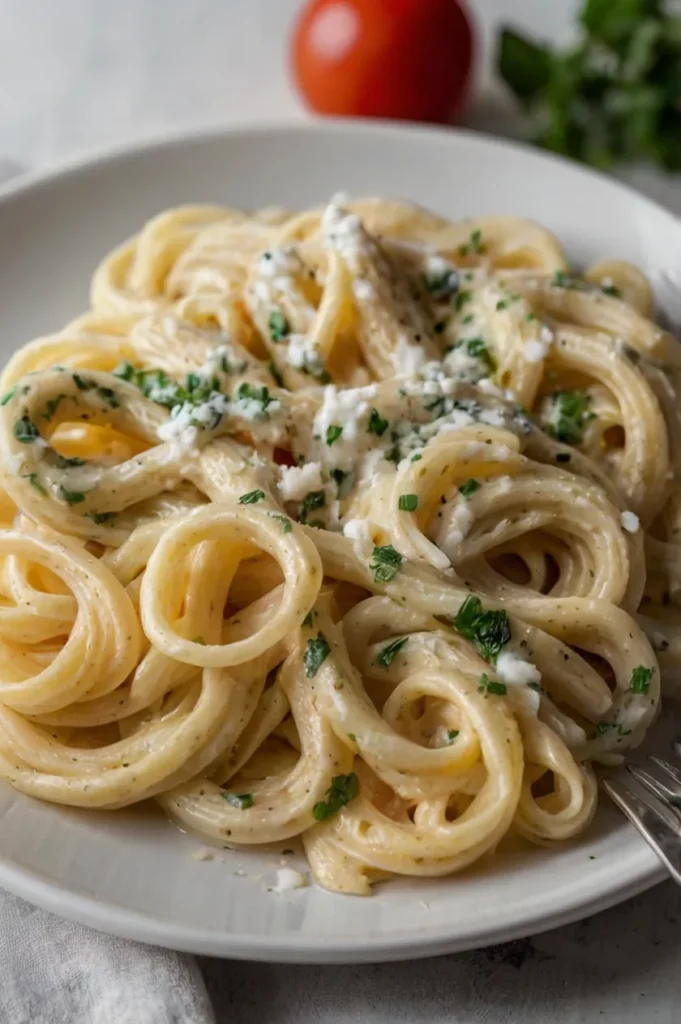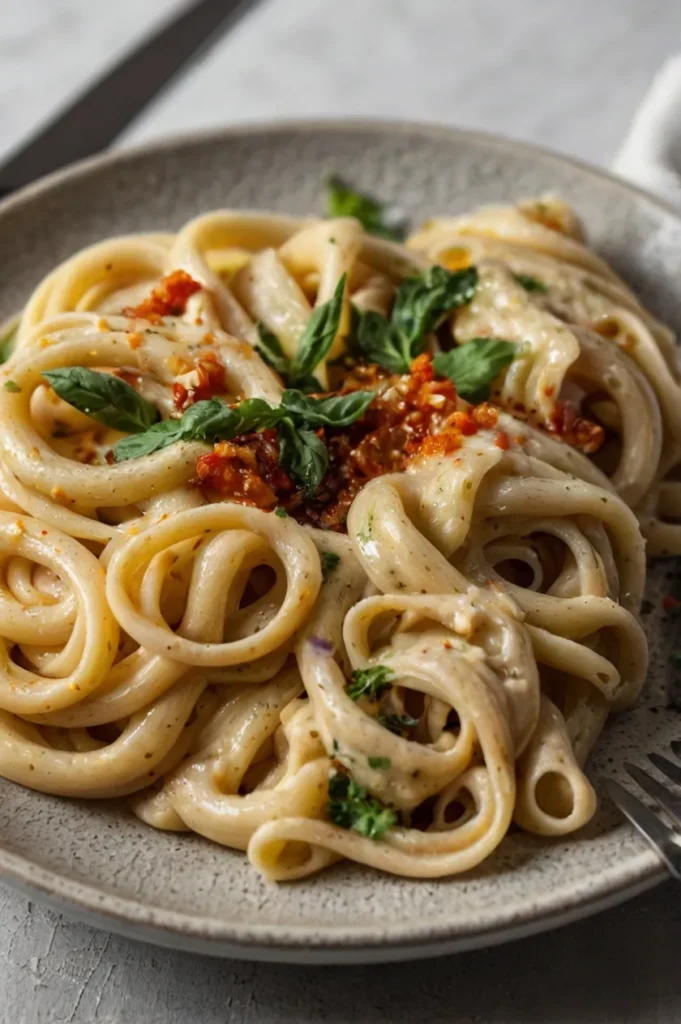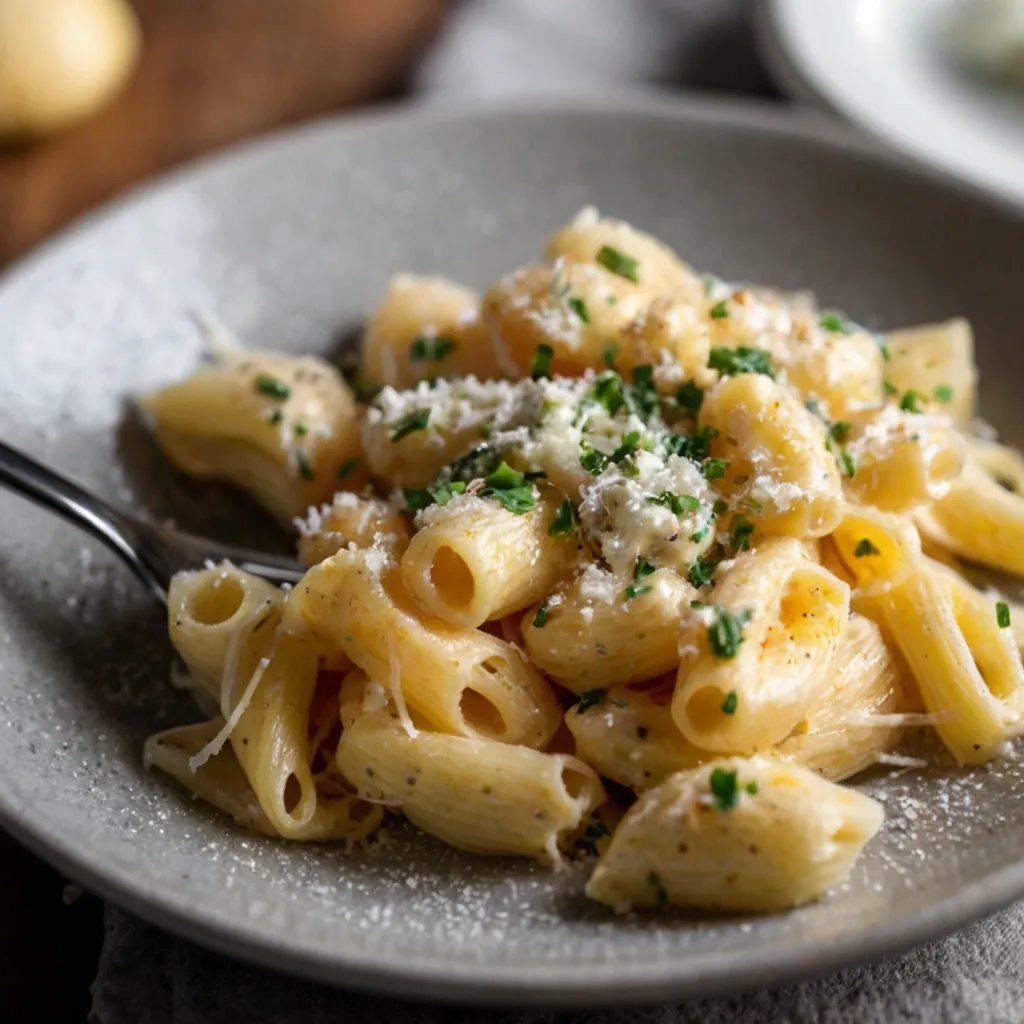The Ultimate Creamy Pasta with Ricotta Recipe (Easy & Ready in 20 Mins!)
Master the perfect pasta with ricotta recipe: creamy, quick (20 min!), and foolproof. Get chef-tested tips for silky sauce every time!
There’s something undeniably comforting about a bowl of pasta coated in a silky, cloud-like ricotta sauce. This pasta with ricotta recipe has been my go-to for years when I need a quick yet satisfying meal that never fails to impress. The beauty lies in its simplicity – a few quality ingredients coming together to create a dish that’s greater than the sum of its parts.
In this comprehensive guide, I’ll walk you through everything you need to know to create the perfect pasta with ricotta. From selecting the right ingredients to mastering the technique that results in a creamy (never grainy!) sauce, plus exciting variations to keep this dish in your regular rotation. Whether you’re a novice cook or seasoned chef, this foolproof recipe delivers restaurant-quality results in just 20 minutes.
Why This Pasta with Ricotta Recipe Works
This pasta with ricotta recipe stands out because it strikes the perfect balance between simplicity and sophistication. The mild, creamy nature of ricotta creates a luxurious sauce without the heaviness of cream-based alternatives. The technique of gradually incorporating starchy pasta water transforms the humble cheese into a silky coating that clings to every bite of pasta.
What makes this approach foolproof is the emphasis on proper technique rather than complicated ingredients. By following the simple steps for tempering the ricotta and emulsifying the sauce, you’ll achieve consistent, restaurant-quality results every time.
Content Overview
Table of Contents
Ingredient Breakdown for Perfect Pasta with Ricotta
For the Classic Pasta with Ricotta (Serves 4):
- 1 pound (450g) pasta (shells, rigatoni, or orecchiette work best)
- 2 cups (450g) whole milk ricotta cheese
- ½ cup (50g) freshly grated Parmesan cheese, plus more for serving
- 2 tablespoons extra virgin olive oil
- 2 cloves garlic, minced
- 1 teaspoon lemon zest (optional)
- ½ teaspoon red pepper flakes (optional)
- Salt and freshly ground black pepper, to taste
- Fresh herbs for garnish (basil, parsley, or chives)
- 1 cup reserved pasta cooking water
Discover more Pasta & Alfredo Recipes
Key Ingredient Notes:
Ricotta: The star of this pasta with ricotta recipe deserves special attention. Opt for whole milk ricotta for the creamiest texture. The quality varies dramatically between brands – look for ricotta that’s smooth rather than grainy. Avoid low-fat versions, which can produce a watery sauce. If possible, fresh ricotta from an Italian deli will elevate this dish tremendously.
Pasta: Choose shapes that can trap and hold the ricotta sauce. Shells (conchiglie), rigatoni, orecchiette, or fusilli work exceptionally well. Their nooks and ridges become perfect vessels for the creamy sauce. Always cook the pasta about 1 minute shy of the package directions for true al dente texture.
Pasta Water: This starchy, salty liquid is the secret ingredient that transforms ricotta from crumbly cheese to silky sauce. Always reserve at least a cup before draining your pasta. The starches act as a natural thickener and emulsifier.
Parmesan: Freshly grated Parmigiano-Reggiano provides both flavor depth and helps with the sauce texture. Pre-grated versions often contain anti-caking agents that can make your sauce grainy.
Seasonings: While the classic version is simple, subtle additions of lemon zest, garlic, or red pepper flakes can enhance the flavor profile without overwhelming the delicate ricotta.
Step-by-Step Instructions for Pasta with Ricotta
- Bring a large pot of water to a boil. Add 1 tablespoon salt (the water should taste like the sea).
- Cook pasta according to package directions until al dente (typically 1 minute less than indicated cooking time). Before draining, reserve 1 cup of pasta cooking water.
- While pasta cooks, prepare the ricotta mixture. In a large bowl, combine ricotta, grated Parmesan, olive oil, minced garlic (if using), and a pinch of salt and pepper.
- Temper the ricotta. This crucial step prevents grainy texture. Take ¼ cup of hot pasta water and slowly whisk it into the ricotta mixture until smooth and silky. This gradually raises the temperature of the ricotta without shocking it.
- Drain the pasta (but don’t rinse!) and immediately add it to the bowl with the tempered ricotta mixture.
- Toss gently but thoroughly, gradually adding more pasta water as needed until the sauce reaches your desired consistency. The residual heat from the pasta and water will warm the sauce without cooking the ricotta (which causes graininess).
- Taste and adjust seasoning with salt and pepper. The sauce will continue to thicken slightly as it cools.
- Serve immediately, garnished with additional Parmesan, a drizzle of good olive oil, fresh herbs, and black pepper.
Chef’s Tips for Perfect Pasta with Ricotta
After making this pasta with ricotta recipe countless times, I’ve gathered some professional insights that make all the difference:
The Magic of Pasta Water
Always save more pasta water than you think you’ll need. This starchy liquid is essential for achieving the perfect sauce consistency. If your sauce seems too thick or the pasta looks dry after sitting for a few minutes, a splash of warm pasta water will revive it.
Avoiding Grainy Ricotta
Never add hot pasta directly to cold ricotta. The sudden temperature change causes the proteins to seize up, resulting in a grainy texture. Always temper the ricotta first by slowly incorporating warm pasta water while whisking.
Seasoning Properly
Taste continuously throughout the process. The pasta water contributes salt, as does the Parmesan, so adjust accordingly. Remember that ricotta is mild, so proper seasoning is essential to avoid a bland dish.
Choosing Quality Ingredients
With so few ingredients, quality matters tremendously. This pasta with ricotta recipe shines brightest when using the best ricotta you can find. Same goes for the Parmesan and olive oil—these flavors are front and center.
Sauce Consistency
The perfect sauce should coat the pasta without pooling in the bottom of the bowl. If it’s too thick, add more pasta water a tablespoon at a time. If it’s too thin, add a bit more grated Parmesan to absorb excess moisture.
Popular Pasta with Ricotta Variations
One of the beauties of this pasta with ricotta recipe is its versatility. Here are some delicious variations to try:
Lemon Ricotta Pasta
Add the zest of one whole lemon and 1-2 tablespoons of fresh lemon juice to the ricotta mixture. The brightness of citrus cuts through the richness of the cheese beautifully. Add the zest to the initial ricotta mixture, but incorporate the juice at the very end to preserve its fresh flavor.

Spinach Ricotta Pasta
For an extra nutritional boost, add 4 cups of fresh spinach (or 1 cup thawed frozen spinach, well-drained). For fresh spinach, add it to the pasta during the last minute of cooking so it wilts perfectly. For frozen spinach, mix it directly into the tempered ricotta mixture. The vibrant green color makes this variation particularly appealing.

Spicy Ricotta Pasta
Increase the red pepper flakes to 1 teaspoon, and consider adding 2 tablespoons of finely chopped sun-dried tomatoes for a hint of sweetness that balances the heat. Toast the red pepper flakes in the olive oil before adding to the ricotta for enhanced flavor.

One-Pot Method
For busy weeknights, you can adapt this to a one-pot approach. Reduce your cooking water by about 25%, and when the pasta is almost done but still quite firm, drain but reserve all cooking water. Return pasta to the pot, add the ricotta mixture, and enough pasta water to create a sauce directly in the pot. This version requires more stirring but saves on cleanup.
Adding Protein
Transform this pasta with ricotta recipe into a complete meal by adding:
- Shredded rotisserie chicken (2 cups)
- Italian sausage, removed from casings and browned (8 ounces)
- Sautéed shrimp (1 pound)
- Tender sweet peas (1 cup, add frozen peas to pasta during the last 2 minutes of cooking.
Discover more Pasta & Alfredo Recipes
Serving Suggestions for Pasta with Ricotta
This pasta with ricotta recipe works beautifully as a main dish, but consider these accompaniments to round out your meal:
- Simple Arugula Salad: The peppery bite of arugula dressed with lemon juice and olive oil offers a perfect contrast to the creamy pasta.
- Crusty Italian Bread: Essential for mopping up any remnants of the delicious ricotta sauce.
- Roasted Cherry Tomatoes: Their sweet-tart flavor complements the mild ricotta wonderfully.
- Wine Pairing: A crisp Pinot Grigio or light Sauvignon Blanc enhances the delicate flavors of this dish.
For a complete Italian dinner experience, serve smaller portions as a primo (first course) followed by a simple protein course like grilled chicken or fish.
Storage & Reheating Instructions
While pasta with ricotta is best enjoyed immediately after preparing, leftovers can be stored and enjoyed later:
Storage: Place cooled leftovers in an airtight container and refrigerate for up to 2 days. Be aware that the pasta will absorb some of the sauce as it sits.
Reheating: The key to successfully reheating this pasta with ricotta recipe is adding moisture. Place leftovers in a skillet over medium-low heat with a splash of water or milk. Warm gently, stirring occasionally, until heated through. Avoid microwaving if possible, as it can make the texture uneven and rubbery.
Make-Ahead Tips: If you want to prepare components in advance, you can cook the pasta ahead of time (undercook it slightly), toss with a bit of olive oil, and refrigerate. The ricotta mixture (without pasta water) can be prepared and refrigerated separately. When ready to serve, warm the pasta, temper the ricotta with fresh hot water, and proceed with the recipe.
Frequently Asked Questions About Pasta with Ricotta
Can I use low-fat ricotta for this pasta recipe?
While you can use low-fat ricotta, the sauce won’t be as creamy or rich. If using low-fat ricotta, you may need to add a tablespoon of butter or additional olive oil to achieve a silky texture.
Why is my ricotta sauce grainy?
Graininess typically occurs when ricotta is heated too quickly or at too high a temperature. Always temper the ricotta by gradually adding warm (not boiling) pasta water while whisking constantly. Also, quality matters—some commercial ricotta brands have additives that affect texture.
What’s the best pasta shape to use with ricotta sauce?
Shapes that can trap the sauce work best for this pasta with ricotta recipe. Shells (conchiglie), rigatoni, orecchiette, fusilli, and farfalle are all excellent choices. Smooth pasta like spaghetti can work, but won’t capture the sauce as effectively.
Can I make this pasta with ricotta recipe ahead of time?
This dish is best enjoyed fresh, as the sauce can thicken considerably when stored. If needed, prepare the components separately and assemble just before serving. When reheating, you’ll need to add additional liquid to restore the creamy consistency.
Can I freeze leftovers of pasta with ricotta?
Freezing is not recommended for this recipe. The texture of the ricotta sauce changes significantly when frozen and thawed, often becoming grainy or separated.
How can I make this pasta with ricotta recipe more flavorful?
Enhance flavor by using fresh herbs (basil, thyme, parsley), toasted pine nuts, caramelized onions, or roasted garlic. Always use freshly grated cheese rather than pre-packaged, and consider adding a splash of white wine to the sauce.
Is this recipe gluten-free?
The ricotta sauce itself contains no gluten, but traditional pasta does. Simply substitute your favorite gluten-free pasta and ensure your cooking time and water amounts are adjusted accordingly, as gluten-free pasta often requires more liquid when creating the sauce.
The Perfect Weeknight Wonder
This pasta with ricotta recipe proves that extraordinary meals don’t require extraordinary effort. With just a handful of quality ingredients and proper technique, you can create a dish that tastes like it came from an Italian trattoria—all in about 20 minutes.
What makes this recipe special is its balance of simplicity and sophistication. The mild, creamy ricotta creates a luxurious canvas that can be enjoyed in its pure form or customized with countless variations. It’s a template for creativity that never disappoints.
Whether you’re cooking for a romantic dinner, a family meal, or simply treating yourself after a long day, this pasta with ricotta recipe delivers comfort and elegance in equal measure. I hope it becomes a staple in your kitchen as it has in mine.
Did you make this recipe? Leave a rating and comment below! I’d love to hear which variation you tried and what you paired it with.
Discover more Pasta & Alfredo Recipes
Recipe Card: The Ultimate Pasta with Ricotta
Prep Time: 5 minutes
Cook Time: 15 minutes
Total Time: 20 minutes
Yield: 4 servings
Category: Main Dish
Cuisine: Italian
Keywords: pasta with ricotta recipe, pasta with ricotta recipes, how to make pasta with ricotta recipe
Description
This quick and creamy pasta with ricotta recipe creates a luxurious dish in just 20 minutes. The secret lies in properly tempering the ricotta for a silky smooth sauce that coats every bite of pasta.
Ingredients
- 1 pound (450g) pasta (shells, rigatoni, or orecchiette)
- 2 cups (450g) whole milk ricotta cheese
- ½ cup (50g) freshly grated Parmesan cheese, plus more for serving
- 2 tablespoons extra virgin olive oil
- 2 cloves garlic, minced (optional)
- 1 teaspoon lemon zest (optional)
- ½ teaspoon red pepper flakes (optional)
- Salt and freshly ground black pepper, to taste
- Fresh herbs for garnish (basil, parsley, or chives)
- 1 cup reserved pasta cooking water
Instructions
- Bring a large pot of water to a boil. Add 1 tablespoon salt.
- Cook pasta according to package directions until al dente. Before draining, reserve 1 cup of pasta cooking water.
- While pasta cooks, in a large bowl, combine ricotta, grated Parmesan, olive oil, minced garlic (if using), and a pinch of salt and pepper.
- Take ¼ cup of hot pasta water and slowly whisk it into the ricotta mixture until smooth and silky.
- Drain the pasta (don’t rinse) and immediately add it to the bowl with the tempered ricotta mixture.
- Toss gently but thoroughly, gradually adding more pasta water as needed until the sauce reaches your desired consistency.
- Taste and adjust seasoning with salt and pepper.
- Serve immediately, garnished with additional Parmesan, a drizzle of olive oil, fresh herbs, and black pepper.
Notes
- For the creamiest sauce, use whole milk ricotta and freshly grated Parmesan.
- The key to avoiding a grainy texture is properly tempering the ricotta with pasta water.
- This dish is best served immediately, as the sauce will thicken as it sits.
- For variations, try adding lemon juice and zest, wilted spinach, or red pepper flakes.
Nutrition Information (per serving)
- Calories: 650
- Fat: 22g
- Carbohydrates: 85g
- Protein: 28g
- Sodium: 580mg
- Fiber: 4g
Nutritional information is an estimate only and may vary based on specific ingredients used.

